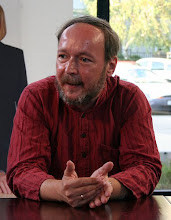
Attempting to relax the trauma triggering IPS event on Sunday I went to Mahabalipuram. "The monuments are mostly rock-cut and monolithic, and constitute the early stages of Dravidian architecture wherein Buddhist elements of design are prominently visible. They are constituted by cave temples, monolithic rathas (chariots), sculpted reliefs and structural temples. The pillars are of the Dravidian order. The sculptures are excellent examples of Pallava art.
It is believed by some that this area served as a school for young sculptors. The different sculptures, some half finished, may have been examples of different styles of architecture, probably demonstrated by instructors and practiced on by young students. This can be seen in the Pancha Rathas where each Ratha is sculpted in a different style.
Some important structures include:
Thirukadalmallai, the temple dedicated to Lord Vishnu. It was also built by Pallava King in order to safeguard the sculptures from the ocean. It is told that after building this temple, the remaining architecture was preserved and was not corroded by sea.
Descent of the Ganges - a giant open-air bas relief
Arjuna's Penance - relief sculpture on a massive scale extolling an episode from the Hindu epic, The Mahabharata.
Varaha Cave Temple - a small rock-cut temple dating back to the 7th century.
The Shore Temple - a structural temple along the Bay of Bengal with the entrance from the western side away from the sea. Recent excavations have revealed new structures here. The temple was reconstructed stone by stone from the sea after being washed away in a cyclone.
Pancha Rathas (Five Chariots) - five monolithic pyramidal structures named after the Pandavas (Arjuna, Bhima, Yudhishtra, Nakula and Sahadeva) and Draupadi. An interesting aspect of the rathas is that, despite their sizes they are not assembled — each of these is carved from one single large piece of stone."
It is believed by some that this area served as a school for young sculptors. The different sculptures, some half finished, may have been examples of different styles of architecture, probably demonstrated by instructors and practiced on by young students. This can be seen in the Pancha Rathas where each Ratha is sculpted in a different style.
Some important structures include:
Thirukadalmallai, the temple dedicated to Lord Vishnu. It was also built by Pallava King in order to safeguard the sculptures from the ocean. It is told that after building this temple, the remaining architecture was preserved and was not corroded by sea.
Descent of the Ganges - a giant open-air bas relief
Arjuna's Penance - relief sculpture on a massive scale extolling an episode from the Hindu epic, The Mahabharata.
Varaha Cave Temple - a small rock-cut temple dating back to the 7th century.
The Shore Temple - a structural temple along the Bay of Bengal with the entrance from the western side away from the sea. Recent excavations have revealed new structures here. The temple was reconstructed stone by stone from the sea after being washed away in a cyclone.
Pancha Rathas (Five Chariots) - five monolithic pyramidal structures named after the Pandavas (Arjuna, Bhima, Yudhishtra, Nakula and Sahadeva) and Draupadi. An interesting aspect of the rathas is that, despite their sizes they are not assembled — each of these is carved from one single large piece of stone."
The 2004 tsunami had a major impact here. "An ancient port city and parts of a temple built in the 7th century may have been uncovered by the tsunami that resulted from the 2004 Indian Ocean earthquake. As the waves gradually receded, the force of the water removed sand deposits that had covered various rocky structures and revealed carvings of animals, which included an elaborately carved head of an elephant and a horse in flight. A small square-shaped niche with a carved statue of a deity could be seen above the head of the elephant. In another structure, there was a sculpture of a reclining lion. The use of these animal sculptures as decorations is consistent with other decorated walls and temples from the Pallava period in the 7th and 8th centuries.
The Archaeological Survey of India sent divers to begin underwater excavations of the area on February 17, 2005." (Quotes from Wikipedia)
The Archaeological Survey of India sent divers to begin underwater excavations of the area on February 17, 2005." (Quotes from Wikipedia)

No comments:
Post a Comment